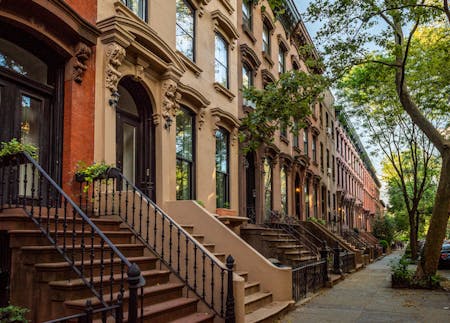What is a Colonial House? Key Style Features to Watch
By Sean Creamer on October 25, 2023
If you're searching for a home, chances are you've come across a Colonial-style house.
This storied architectural style stands as a symbol of the country's historical and architectural heritage. Symmetrical design best describes Colonials, which have remained a staple of the style over the evolution of the home in the United States.
Many buyers today seek Colonial-style homes for their historic charm, decorative front entrances, and practical living spaces. To give buyers a deeper understanding of the style, the team at Prevu Real Estate defines the Colonial home below.

What are Colonial houses?
The Colonial traces its roots to the founding of the American colonies, dating back to the 17th and 18th centuries.
Colonial houses often emphasize balance and usually feature a door in the middle of the home flanked by an identical number of windows on either side. Colonial houses often feature a steep, pitched gable roof that allows snow to slide off easily, preventing the accumulation of weight that could damage the structure during the harsh northeast winters.
Wooden construction characterized Colonial builds in the early years, but brick and other types of siding became prevalent.
Colonials traditionally have two stories, with a large, centrally located chimney and floor plans emphasizing symmetry. Interior layouts have changed throughout the years, but today's designs exude practical functionality, good lighting, and charming design.
What is the history of the Colonial house style?
As European settlers made their way to the Americas in the 1600s, they brought the British Colonial style with them, adapting their architectural traditions to the new world's conditions.
The materials of choice for English settlers were timber frame construction and wood siding, courtesy of the region's abundant forests. The Dutch settling in the Hudson River Valley area used stonework for longevity and have dormer windows at the roof line. Both early styles utilized steep gables and overhanging eaves to drive snow weight off the structures.
Throughout the 18th and 19th centuries, other styles came into vogue, and the style became a footnote in architectural history. In the early 20th century, however, Americans became fascinated with the different types of colonial style homes on the East Coast. This lead to a revival period that lasted through World War I and II before ebbing in the mid-1950s.
PREVU SMART TIP
Did you know you can get a rebate from your real estate broker? Buying with Prevu you’ll pocket a buyer's rebate up to 1% of your home's purchase price. On a $1,500,000 property, you’d receive up to $15,000 cash back.
Get cash back when you buy a home!What are the key features of a Colonial house?
Equal proportions are a defining feature of the Colonial style. Classical European architectural principles of balance significantly shaped the design, emphasizing symmetry as a reflection of order and beauty.
Symmetry also helped optimize space, making it easier to distribute rooms and simplifying construction. Moreover, the visual appeal of a centrally-located front door flanked by mirrored windows contributed to the overall aesthetics of the homes.
Colonial houses are known for their multi-pane windows, typically featuring small panes of glass arranged in a grid pattern. This design adds to the aesthetic appeal and allows for more efficient temperature control.
Another common feature in Colonial homes is the central chimney, which served a practical purpose by spreading heat into multiple rooms while maintaining the home's symmetry.
What are the different varieties of the Colonial style?
As America grew, Colonials became fixtures in the fledgling nation. But as people spread throughout the South and West, building styles evolved to fit the times and geographies folks moved to.
For instance, the New England Colonial style offsets snow and cold weather via steeply gabled roofs, central fireplace, and a rectangular or square footprint. Conversely, the Southern Colonial style features large, columned porticos with grand entrances and expansive front porches. The warm, humid climate of the South also influenced the design, with wide eaves and high ceilings that promote ventilation becoming prominent features in this version of the Colonial.
Dutch Colonials in the Hudson River Valley of New York have gambrel roofs featuring a double slope on each side. If you encounter a Colonial-style home with a brick facade and white columns, it is likely a Georgian Colonial. The symmetry of brickwork appealed to settlers, and the material had a longer lifespan than clapboard wood siding building materials originally used for homes built in Massachusetts and Connecticut.
Spanish Colonial homes similarly use different materials, featuring stucco walls and terracotta roof tiles and sometimes have side gables branching off the home.
Cape Cods are a popular take on the Colonial style. These great starter homes are known for their single-story, steeply pitched roofs, central chimneys, and minimalistic design. Colonial homes with roofs that slope longer on one side are Saltbox Colonials. These are typically larger than other types of Colonial homes.
Where can you find Colonial houses?
The influences behind the Colonial style came from England, but settlers took these inspirations and built a uniquely American home in the Northeast.
Over time, the style spread from New York, Massachusetts, and Connecticut into the American South.
In the 20th century, the Colonial Revival movement saw this historic house make a comeback with new materials and modern utilities. Today, you can find newer Colonials featuring vinyl siding and improved windows in places like Denver, parts of Texas, and up and down the California coast.
Interested in buying a house? Browse listings in your favorite city and see how much you can save with Prevu’s Smart Buyer Rebate.











